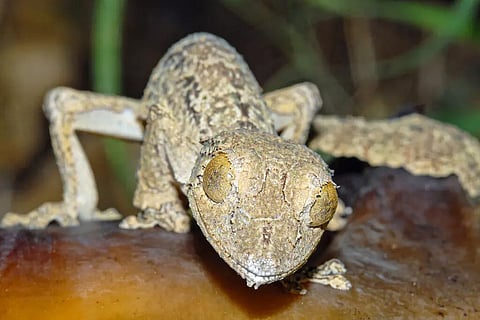

By Sofia Quaglia
NEW YORK: As night falls on the northern forests of Madagascar, trees come alive. What appears to be a piece of bark peels off a tree trunk, and starts slowly crawling along a branch. It’s actually Uroplatus garamaso, a newly identified species of leaf-tailed gecko. This animal is a dazzling camouflager — better than the chameleon — but it’s long been hiding in plain sight. And many of the features that make it unique are still an evolutionary mystery.
“These are amazing animals. They are so weird. They look totally different from all of the other reptiles,” said Mark D. Scherz, curator of herpetology at the Natural History Museum of Denmark and a co-author of the paper in the journal Salamandra describing the find last month.
The 22 species of leaf-tailed geckoes that are unique to Madagascar can be split into two categories: those who’ve evolved to look uncannily like leaves, and those who imitate tree bark. U. garamaso and the others that blend into bark have a fringe hugging their flanks and legs, a beard around the bottom of their chin, and flattened tails.
During the day, they fold out that fringe and rest on tree trunks, becoming “practically invisible,” Dr. Scherz said. At night, they come out of that sleeping position and prowl the forest for invertebrate prey, like “little leopards or jaguars,” he added.
U. garamaso is so talented at disguise that for decades, it’s been mistaken for another leaf-tailed gecko in Madagascar called U. henkeli. It was probably British pet traders in the early 2000s who first wondered if they had their hands on a different beast, Dr. Scherz said. The traders noticed small physical differences. This lizard is smaller than U. henkeli and has a slightly narrower tail. Its diamond-pupiled eyes are tinted a gaudier yellowish-red.
“It’s been out in the pet trade, sampled on numerous occasions for various studies; the genetic distinctness was somewhat recognized,” said Rebecca J. Laver, a researcher at Australian National University who was not involved in the study. “But whilst sometimes new species are discovered and instantly obvious as being something new, these geckos are really masters of camouflage in multiple ways.”
It took decades of research on U. garamaso’s genetics, morphology and evolutionary lineage for Dr. Scherz’s team to pinpoint the key tell: The tip of the gecko’s tongue is black, rather than pink.
“Almost all of them have a distinct mouth color, and it turns out to be incredibly important for identifying species in this genus,” Dr. Scherz said. “That feature lines up beautifully.” Some species have totally black mouths, while others sport bright yellow or pink. But scientists have no clue why this cheeky difference has emerged among species, and what it’s good for. It could be part of a private communication signal, or it may be used to distinguish one another among species. It could be a warning or mating sign or used for male-on-male combat. “There is really something very unusual happening that we can’t explain at the moment,” Dr. Scherz said.